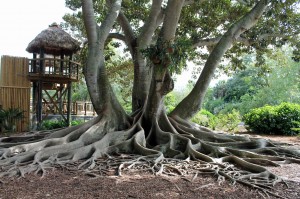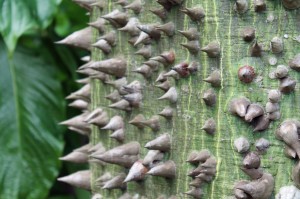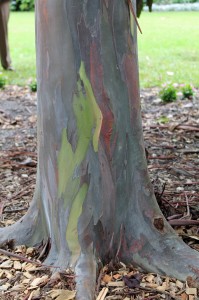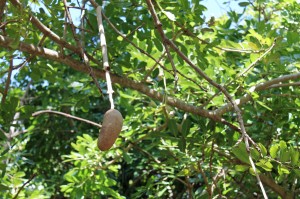Believe-It-Or-Not Trees
January 28th, 2014
Trees, like most living things, will do what it takes to keep living.
Even it means killing other trees.
I’d never encountered a directly and intentionally murderous tree until running into a so-called “Florida strangler fig” last week at Sarasota’s beautiful Marie Selby Botanical Gardens.
Skinny gray trunks of this tree were working their way around a peace-loving palm like the Boston strangler’s fingers around a throat.
The sign said this strangler fig (Ficus aurea) eventually would surround and overtake the palm, killing it and letting behind a fig with a hollow center as the palm wood rots.
It’s actually a clever, albeit diabolical, way for this species to compete in its native rainforest environment, where sunlight is at a premium. Whoever gets to the light first wins.
What the strangler fig does is use birds to eat its fruit and then drop its seeds into the crevices of existing trees.
When a seed germinates, the tree sends aerial roots down into the ground to root while branches work their way up. It’s fast-growing enough that it usually outpaces the host and wins the sunlight war.
That was just one weirdo tree I saw on a polar-vortex-escaping trip to central Florida.
Another eerily oddball species was the Moreton Bay fig (Ficus macrophylla). This Australian native has strangling tendencies, too, but the main feature is the wall-like buttress roots.
The tree can become huge – upwards of 200 feet. To support that size, the big roots creep out and grow up in vertical panels about a foot tall.
If you’ve ever seen the movie “Jurassic Park,” this is the tree where the characters found dinosaur eggs nestled among the roots.
You won’t forget a Moreton Bay fig if you ever see one, but it’s seldom planted even in warm climates because the roots are so aggressive.
Another tree that just looks plain mean is the floss silk tree (Ceiba speciosa). Native to South America, the floss silk’s very noticeable identifier is the spikes you’ll find all over the trunk.
Calling them “thorns” would be an injustice. These things have sharp points on the ends of fat, little cones that project from the trunk surface, earning the tree its other nickname of “monkey no climb.”
The branches also have prickles, making this is a tree that’s telling the rest of nature to let it alone. Be careful backing up anywhere near one.
Besides the self-protection, those conical spikes help the tree store water for drought survival.
The floss silk tree gets that name from the fluffy stuff that surrounds the bean-sized seeds inside the fruiting pods. The flowers are a cream and pink bicolor and look a bit like hibiscus.
A nicer Florida tree that caught my eye was the rainbow gum tree, which is actually a type of eucalyptus (Eucalyptus deglupta) – the only eucalyptus found naturally in the northern hemisphere.
The rainbow gum gets its name from the multicolored peeling bark. As the bluish-gray outer bark flakes off, the tree shows patches of inner bark that’s a bright green.
That, in turn, matures and morphs into shades of pink and coppery brown on the specimen I saw, but apparently can include shades of purple, orange, blue and deep red as well.
And one last fun tree species was the aptly named “sausage tree” (Kigelia pinnata). It’s another big tree and hails from Africa.
The name comes from the hanging, oblong, tan fruits that look like sausages dangling at a butcher shop. They’re not edible (except by really hungry wildlife), but they sure don’t look like any fruit I’ve seen on a Pennsylvania tree.
Also curious: the large, downward-facing, blood-red flowers are pollinated by bats.
Interesting trees. We won’t be growing any of them in zero-degree winters. But on the bright side, at least we don’t have to worry about our dogwoods strangling our redbuds.












